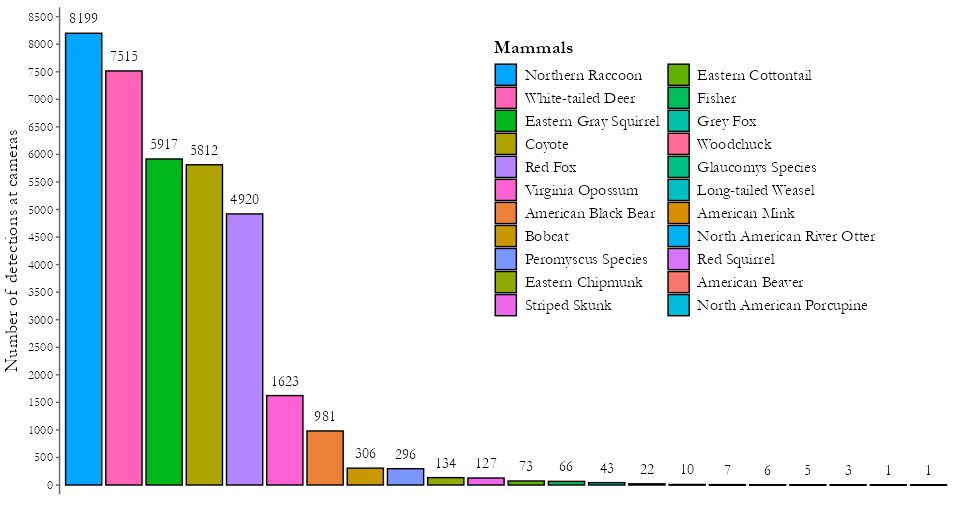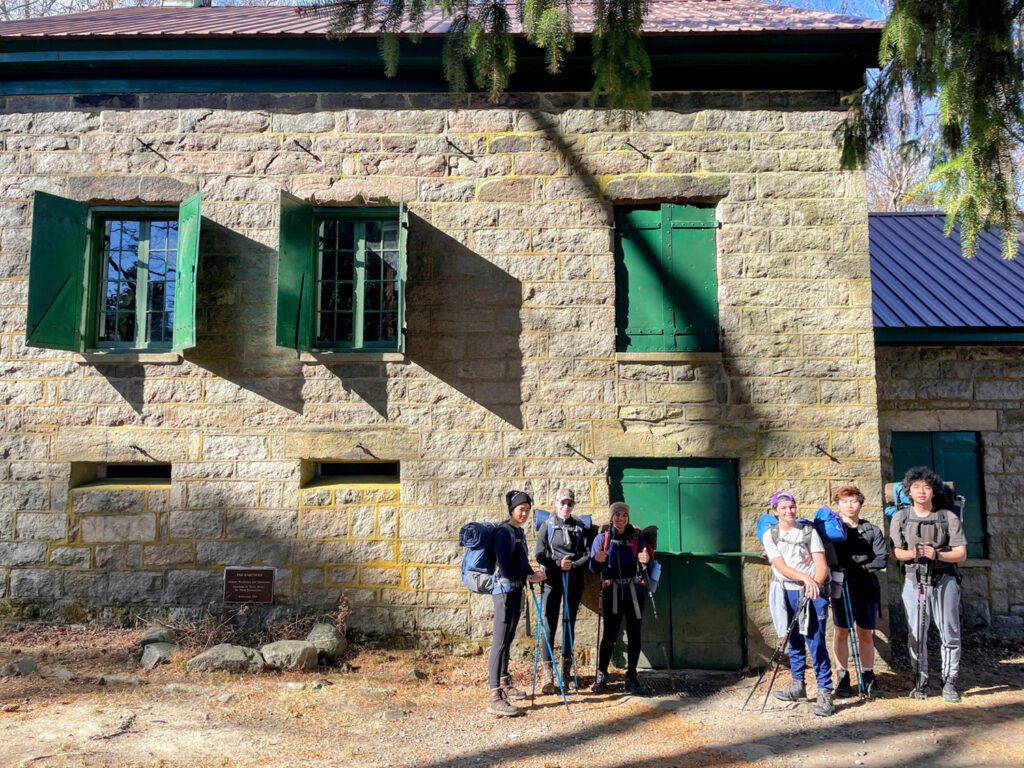Watching Mammals: Research at Black Rock Forest

The first steps of science are to observe and record. Early ecologists were armed with sketchbooks and attention to patterns. Biologists performed dissections, drew what they found inside and speculated on functions. Many of us still do this, but we’ve largely replaced our drawing skills with photography, for better or worse. I’ve never been called an artist, so when given the chance over 20 years ago, I was quick to replace my pencil with a camera, of sorts. I now install cameras, i.e., “camera traps”, across Black Rock Forest and much of our surrounding landscape. Why? To observe, record, and eventually compare.
One of our research goals is to better understand what lives inside and near Black Rock Forest. Camera traps are rugged, motion-activated, self-contained cameras that can be installed almost anywhere to take pictures of passing animals. Since they make no noise nor flash, they are useful tools for documenting wildlife without disturbing them. Their images tell us what species are present, how many, when, and where (since we know where we placed the camera trap). We use these data to test hypotheses on animal habitat preferences, or quantify population estimates, or for simple annual accounts of species presence.

Over the last six winters, our camera traps have silently observed 104 sites, recording 36,067 passes by wild mammals, from >1.3mil pictures taken throughout the Forest and nearby public and private lands. Our most commonly detected mammals are likely the ones you would expect: Northern Raccoon (Procyon lotor; 8199), White-tailed Deer (Odocoileus virginianus; 7515), Eastern Gray Squirrel (Sciurus carolinensis; 5917), and Coyote (Canis latrans; 5812) (Figure 1). (Note that the numbers inside the paratheses indicate how often individuals of each species have been detected, not the number of individuals or any form of population estimation.)
A few species are surprisingly rare (e.g., Red Squirrel (Tamiasciurus hudsonicus; 3), and Grey Fox (Urocyon cinereoargenteus; 43)) while others are apparently not present (e.g., Short-tailed Weasel; Mustela erminea), and others have not been detected in Black Rock Forest but nearby (e.g., North American Porcupine (Erethizon dorsatum; 1) and Fisher (Pekania pennanti; 66). These surveys allow us to compare to earlier species accounts, including a 1965 account of the Bear and Harriman Mountain State Parks that listed the American Black Bear (Ursus americanus), Coyote, or Fisher as absent and Bobcat (Lynx rufus), Porcupine, and the North American River Otter (Lontra canadensis) as ‘very rare’.

We can take a step further and explore species daily activity patterns (Figure 2). By extracting the time of day at which each species was detected at a camera trap, we can draw conclusions on their activity patterns. For example, we can see that our Coyote are rarely active during the day, apparently much more active after 6PM and until 6AM. Whereas White-tailed Deer may be active throughout the 24-hr day, but with activity peaks around dawn and dusk.
We intend to continue our camera surveys, observing and recording our resident wildlife indefinitely. Consider installing a camera in your own backyard. You might find a neighbor you never knew you had. ❦
—Scott LaPoint, PhD,
Director of Research, Black Rock Forest
Advancing Energy Efficiency and Sustainability

A team of Barnard College students, as part of the Workshop in Sustainable Development course, recently completed a comprehensive analysis of Black Rock Forest’s energy systems. The team—Bria Dominici, Monica Wu, Samantha Candelo Ortegon, Antonia Schnitzler, Amelia Ding, Charlotte Lawrence, Eva Das, and Shehar Bano—developed innovative recommendations to enhance sustainability for the Forest Lodge while reducing costs. Under the direction of Dr. Terryanne Maenza-Gmelch, the students collaborated with Black Rock Forest Facilities staff, including Dr. Isabel Ashton, Matthew Brady, and Matthew Munson.
The study revealed that energy consumption at Black Rock Forest peaks during winter months due to heating demands, with little correlation to visitor numbers. The geothermal systems at the Lodge efficiently maintain comfortable temperatures in the summer but face challenges during the winter. By examining utility bills and energy consumption data, the team estimated that since 2003, the solar array has saved $204,312.11, while the geothermal system has saved $441,822.48. Composting toilets were found to conserve approximately 30,000 gallons of water annually. For a nonprofit organization, these savings are significant, allowing funds to be redirected to educational and research programming.

To build on this success and keep Black Rock Forest at the forefront of sustainability, the team proposed integrating additional green technologies, such as installing heat pumps and expanding the Lodge’s solar capacity. They also emphasized behavioral strategies, including real-time energy monitoring, incentivized savings programs, and timed HVAC systems, to foster a culture of conservation. Furthermore, the team developed educational signage to engage visitors and highlight the impact of sustainable practices.
Thanks to the incredible work and dedication of these students, Black Rock Forest now has a clear roadmap to further its leadership in sustainable development, enhance energy efficiency, and reduce its carbon footprint. With strategic investments and community support, the Forest is poised to remain a model of environmental responsibility and innovation. ❦
—Isabel Ashton, PhD,
Executive Director, Black Rock Forest
Autumn Adventures at Black Rock Forest

The Storm King School Outdoor Adventure Club has a long history of exploring Black Rock Forest. This past November, as part of their rigorous Outdoor Adventure Award, a select group embarked on an overnight backpacking expedition. Their journey led them to the historic Stone House. Originally built in 1834 as the Chatfield farmhouse, it was destroyed by fire in 1907, until it was rebuilt in 1932 and renamed the Stone House. A location steeped in local legend, it is also the oldest building in Black Rock Forest.
Robert MacSwain, science teacher and Outdoor Adventure club advisor, shared that “students have been physically training by hiking a variety of difficulty level hikes and learning many expedition skills such as map reading and navigation, wilderness first aid, wilderness cooking and nutrition, and many other survival skills to prepare them for their expedition. Before students went on their overnight expedition, they had to plan their five-mile hiking route, organize essential kit and equipment, and prepare a suitable meal plan for the two days.” This challenging expedition also included summits of Whitehorse Mountain, Mount Misery, and Black Rock Mountain, culminating in an overnight stay at the famously-haunted Stone House.
The Outdoor Adventure Club, today headed by Rob and Angelica Centeno, has been exploring the Forest since 2017. Last year, they brought students on hikes over 20 times, exploring everything from the Duggan Trail to Aleck Meadow Reservoir to Mineral Springs Brook. We are thrilled that students are able to connect with the outdoors through this program, not only fulfilling their physical fitness requirements, but also providing them with valuable learning experiences in a natural setting.
A memorable field trip was experienced by fifth graders from Cornwall Central Middle School. Their art teacher, Mary Mires, creatively integrated the work of Andy Goldsworthy into their lesson plan. This exploration of environmental art, which often involves using natural materials, allowed students to connect with the concepts of earth art and land art while fostering an appreciation for the beauty and transience of the natural world.

2024.


Ms. Mires shared, “We are so lucky to live in such a beautiful place surrounded by seasonally changing nature. The artist Andy Goldsworthy leaves his finished work in nature. He knows his work is only temporary, and could later be destroyed in its natural environment. As a result, his photographs become an equally important piece of his work. Pushing students to only use materials they have found in their natural setting challenges them to create and think differently. Students must take into account what may occur during the passage of time following the day they created their work. Goldsworthy built his 2,278-foot stone wall, Storm King Wall, on the foundations of an old dairy farm wall found in the woods overlooking Moodna Creek in New York’s Hudson Valley. Using field stones he speculated what may happen to his wall over time. Goldsworthy created a relationship between ground, sky, water and trees.”
We were really inspired by the diversity of work the fifth graders displayed and were thrilled to welcome the following classes throughout October 2024: Ms. Malings, Ms. Vangas, Ms. Borland, Ms. Briscoe, Ms. Young, Mr. Cassel, Ms. Sabini, Ms. Dabroski. We were grateful to have no weather cancellations this season (due to the driest autumn in nearly 50 years, according to the Cary Institute), so all the students benefited from fresh air and new hikes, while learning about different things in their environment, from glacial erratics to fall migration birding to the historical relevance of Spy Rock. Ms. Jennifer Borland observed, “It also encouraged them to think critically about the relationship between humans and the environment, inspiring them to create art that respects and reflects nature’s ever-changing landscape.” ❦
—Jessica Schnell, PhD,
Director of Education, Black Rock Forest
Forest News in Brief

Save the Date!
Black Rock Forest’s annual benefit luncheon will be held at Tavern on The Green in New York City on Wednesday, May 14, 2025. More information at blackrockforest.org/Benefit2025

Calling all Volunteers!
Earth Day is just around the corner and Black Rock Forest is gearing up for tree planting, trash cleanup, and removing invasive plants. Look for more information coming soon.

Love Plants and Hiking?
Help us track climate change by becoming a phenology volunteer! Phenology volunteers hike a one-mile trail weekly from spring thru fall to collect data on native trees and flowers. Training is scheduled for Saturday March 8, 2025.

Join the Black Rock Mountain Society
Ensure that Black Rock Forest thrives for generations to come by including the Forest in your estate plans. Planned giving, such as bequests, is a meaningful way to support conservation, education, and research for the future. For more information on how to leave a lasting legacy, please check out our website or contact us for more information.

Flood Recovery Update
In July 2023, a severe rainstorm and subsequent flooding caused significant damage to Black Rock Forest’s trails, roads, and buildings. Thanks to your unwavering support and patience, we’re thrilled to share that in January 2025, we finalized our last grant and secured funding for recovery from the Federal Emergency Management Agency (FEMA) and the New York State Division of Homeland Security and Emergency Services. With these funds, we’re preparing to replace lost trail bridges and begin repairs to Sibyl’s Path this spring and summer. These projects will restore vital connections within the forest, ensuring all visitors can continue to experience the beauty and wonder of our trails. Thank you for standing by us through this process. Together, we’re building a stronger and more resilient forest for generations to come.

Deer Management Update
Large populations of deer can negatively impact forests by overbrowsing trees, reducing biodiversity, hindering forest regeneration, and allowing invasive species and ticks to thrive. Thanks to the dedication of hunters from the Black Rock Fish & Game Club who participated in our deer management efforts, we are working to keep our forest healthy. During the regular deer season, there were 190 hunter efforts, resulting in the harvest of 18 bucks and 6 does.

Please consider supporting our programs by becoming a Friend of the Forest

If you would like to download
a copy of this Winter 2025 newsletter CLICK HERE.

